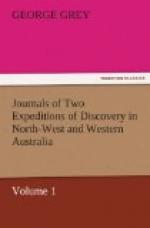As this is the first specimen of Australian taste in the fine arts that we have detected in these voyages it became me to make a particular observation thereon: Captain Flinders had discovered figures on Chasm Island, in the Gulf of Carpentaria, formed with a burnt stick; but this performance, exceeding a hundred and fifty figures, which must have occupied much time, appears at least to be one step nearer refinement than those simply executed with a piece of charred wood. Immediately above this schistose is a superincumbent mass of sandstone which appeared to form the upper structure of the island.
(Footnote. King’s Australia volume 2 page 25.)
...
PAINTINGS IN THE YORK DISTRICT.
There is a third instance of a cave with a figure in it in the district of York, in the settlement of Swan River; but in this case the species of circle which is drawn on the cave, or rather scraped into it with a piece of stone, may represent anything or nothing; in fact it is no more than any idle or thoughtless savage might have executed, without any fixed design whatever. The only other vestige of drawing contained in the cave is evidently the mere impression of a hand, which has been rubbed over with the red paint with which the natives are in the constant habit of bedaubing themselves, and has then been pressed in on the wall.
NATIVE TRADITIONS.
I had been told that the natives had some very curious traditions current amongst them with regard to this last cave and, after having visited it and satisfied myself that there was no analogy between it and the caves on the north-west continent of Australia, I set about collecting some of the native stories that related to it. These legends nearly all agreed in one point, that originally the moon, who was a man, had lived there; but beyond this there was nothing common to them all, for every narrator indulged his own powers of invention to the greatest possible degree, scarcely ever relating the same story twice, but on each occasion inventing a new tradition; and the amount of marvels and wonders which he unfolded in this revelation were exactly proportioned to the quantity of food which I promised to give him. I once or twice charged them with attempting to impose upon my credulity and, far from denying the charge, they only laughed and said, “that was a very good thing which they told me, and that the Djanga (white men) liked it very much.”
COLOURS USED IN PAINTING.
In the painted caves on the north-western coasts five colours were used: red, several shades; yellow; blue; black, and white. With the exception of blue these colours are all known to the natives of the whole continent. The red they either dig up from the earth, fit for use, in the form of red earthy pebbles, or they find it in the form of a brilliant yellow clay, which they beat, clean, and dry, leaving it exposed to the air for several days, when they bake it in a bark basket, and then, if the clay is good and it has been well prepared and burnt, it is nearly as bright as vermilion. In some parts of the continent however no good clay can be found; and in this case, at their annual fair, where they meet to exchange certain commodities only locally produced, this brilliant red ochre is considered a very valuable article of traffic.




